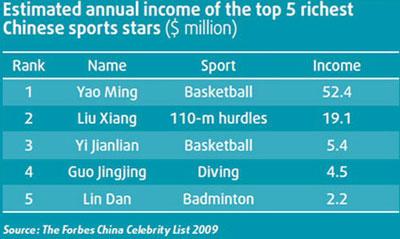
China's sports industry is getting more popular, more profitable, and more international. [Photo: China Daily]
Yao Ting, a young white collar worker from Beijing, has been going to the gym twice a week for more than a year. In addition to body-building she also plays tennis and badminton.
Yao is part of a new generation for whom sport is an important part of leisure, and it is fueling an increasingly important part of the economy at a time when other areas are being hit by financial meltdown.
According to a survey conducted by the State General Administration of Sport last year, about 340 million people exercised regularly in 2008, with 250 million of them spending an average of 593 yuan ($88) per annum on sport or sport-related activities.
The survey also said a record 28.2 percent of the population spent more than 30 minutes on physical training at least three times a week.
The authorities said the figures reflected rising health awareness among urban residents since 2001, when Beijing won the right to host the 2008 Olympic Games.
"Compared with the situation more than 10 years ago, people's awareness of sport has been increased, thanks to the development of the sports industry in China," said Wei Jizhong, chairman of the China Sports Industry Co Ltd. "At the same time, the demands of people and the market will further push the development of the sports industry."
Multinational sports companies have already benefited from demand for their products in China.
Sales of the US sports giant Nike rose 50 percent in China in the first half of last year. The company also announced that it had reached its original goal of $1 billion in sales in China a year ahead of original projections.
At present, Nike is the number one sports brand in China, and currently China is the company's second-largest market behind the United States.
On the back of solid domestic demand, an increasing number of local sports brands have sped up their entry into the global market in a search for new customers.
From tennis supremo Jelena Jankovic to pole vault queen Yelena Isinbayeva and National Basketball Association courts across the United States, Chinese sports brands are shrugging their shoulders at the global economic downturn and signing high-profile deals with elite stars and franchises to make their presence felt in the world market.
Local brand Anta was the first to make a major move this year by signing former world number one Jankovic during January's Australian Open. Although the cost of the agreement was not disclosed, Anta is believed to have lured the Serb away from Reebok with a multi-million-dollar three-year deal.
This was a bold move given the unforgiving economic climate that has seen brands sever massive endorsement deals in recent months. The ending last year of the association between Buick and Tiger Woods, reputed to earn the golfer $8 million a year, is a case in point.
Anta officials said the company had managed to avoid the full brunt of the downturn by focusing on domestic demand.
"Up to now, the economic crisis has had little impact on our company," said vice-president Mao Yuying. "We don't expect to get the same rate of return compared with our investment in Jankovic, but we hope to lift our brand to new heights by capitalizing on her global fame."
Anta is not the only local sportswear titan enjoying brisk business.
Li Ning snapped up Russia's double Olympic champion Isinbayeva in March, with its "Sky no limit for me" advertising campaign, which subsequently took the mainland by storm.
Li Ning had already signed up a crop of US National Basketball Association stars including Shaquille O'Neal, Baron Davis, Damon Jones and Jose Calderon.
The brand has also cemented partnerships with the Association of Tennis Professionals (ATP) and the Spanish national basketball team.
Commercialization and globalization have not only benefited these companies, but also the sports associated with them.
The bringing in of league match systems for some sport events in China, such as soccer, basketball, table tennis and volleyball, has helped them to be more professional and given them more space to develop according to market requirements rather than through government investment.
Over the past 15 years, the Chinese Basketball Association (CBA), thanks in large part to help from the NBA, has cultivated 300 million local basketball fans.
"The CBA could be considered one of the successful league competitions in China," said Wei.
"Whether it's a company or a sport, the key factor for its development is how to design satisfactory products for the market."
Not only does sport need hard and fast rules to attract interest, it also requires effective marketing.
The Chinese Olympic Committee (COC) learned many lessons about marketing in the run-up to last year's Olympic Games which will put it in good stead for the new four-year Olympic cycle from 2009 to 2012.
The COC has so far only signed contracts with two sponsoring companies, but the income from them already exceeds the total amount it earned from the last Olympic cycle.
Although final figures have yet to be calculated, estimates indicate the COC earned at least $60 million from the Olympic cycle of 2005 to 2008.
"Sports marketing has become popular for businesses in the wake of the Olympics," said Wang Jun, vice-director of the State General Administration of Sport and vice-chairman of the COC. "Although the post-Olympic sports industry has been affected by the global downturn, crisis and opportunity can co-exist. The sports industry can fight the downturn so long as it makes skilful use of marketing."
